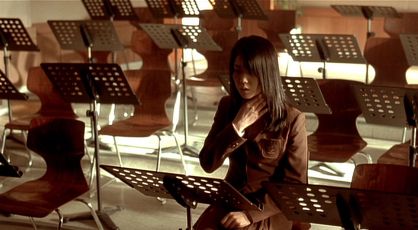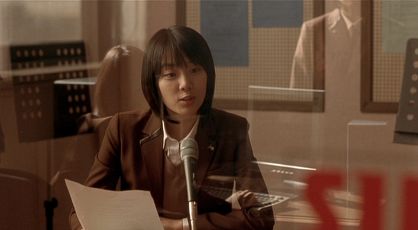« Coffee Break | Main | Richard Fleischer swings between Heaven and Hell »
July 15, 2008
Voice

Yeogo Gwae-dam 4: Moksori
Choe Ik-Kwan - 2005
Genius Products Region 1 DVD
While it is commendable that Genius Products is stepping in to fill a void of films that might have been made available by Tartan Asia Extreme, they aren't doing anyone favors with misleading artwork. The image used for the Voicepackaging, with bloody hands emerging from a young woman's mouth is nowhere in the film, and attempts to sell a concept of gore and unrelieved horror for the less discriminating fanboy. What gore and horror actually exists in Voice is extremely limited and is hardly the point of the film. I don't know what kind of ambitions Choe Ik-Kwan may have, but in Voice he demonstrates a well developed stylist's eye that goes beyond the limits of a genre exercise.
The title is literally translated as "High School Girl's Ghost Story 4: Voice Letter". The film is not a sequel but the fourth of the loose series of ghosts stories largely taking place in a Korean high school for girls. The previous films are Whispering Corridors. Momento Mori and Wishing Stairs. The films are linked by an intense friendship between two students, the mysterious death of a student in the past, and a mysterious teacher. Given that the films are about young women, there is nothing exploitive about the films, made primarily for an audience of older teens. The films are also critical about some aspects of Korean education.

Voice visually explores the idea of high school as a form of hell. At night, the hallways are bathed in red light. Parts of the film take place in the school's basement, corridors of leaky pipes and rot which belies the gleaming modernity of the school's exterior and above ground structure. Even the concept of the elevator or simply the elevator shaft for a one way decent is used here. What makes Voice different from most ghost stories is that part of the film is told from the point of view of the ghost, a young woman who is finds that she may be invisible to most of her classmates, yet is physically limited to the school building in her afterlife.
Voices figure into the story. The main character, Young-Eon, is a student with an extraordinary singing voice. Young-Eon's relationship with the music teacher becomes the subject of rumor. The teacher is a former soprano who is noted for wearing turtlenecks to cover her throat. Young-Eon's best friend, records Young-Eon's voice and has a lunchtime "radio" show broadcast in the school. Part of the mystery involves the voice of an unseen singer that only a few of the girls can hear. Another student, who has had the ability to hear ghosts, comments ominously that ghosts are selective in their memories.
Memory is what Voice explores. It is not only ghosts who have faulty memories as the film demonstrates. One of the less sensitive students states that that one of the rumors about Young-Eon must be factual because it has been repeated so often. Within the confines of the ghost genre is the story about the conflicts young people have between wanting to be part of the crowd against making one's self distinguished by a special talent. The few adults that appear in Voice have a tendency to be useless, with the exception of the one teacher who recognizes the talents of her students. For me, Voice suggests again that Korea has been a hotbed of talented visual stylists. While it will be a few years before we see how the careers of the directors develop, I would make the case that the series of ghosts stories may be viewed in the future as the starting point for new talent much in the way that the Val Lewton produced horror film served in the past.

Posted by Peter Nellhaus at July 15, 2008 06:43 PM
